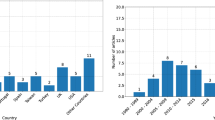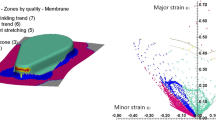Abstract
This article describes tolerance analysis using a reliability-based approach to ensuring that a functional condition is satisfied. A particular feature of this procedure is that it defines the combined effects of geometric and dimensional ISO specifications for product parts, and the architectural parameters that define the relative positions of parts in contact. In the first part, we describe configuring the product parameters by geometric deviations, and from this, a global model is produced to characterise the variation in rotor/stator clearance in a turboshaft engine turbine. This model relies on tolerance zone dimensions, dimensional tolerances and architectural parameters. When clearance is examined using the reliability-based approach, links emerge between the turbine’s architectural parameters and its geometric and dimensional specifications. Indicators can then be deduced which guide the designer in selecting the optimum turbine architectures.













Similar content being viewed by others
Abbreviations
- i, j :
-
Surface j of part i
- i, 0:
-
Nominal model of part i
- D i,jn :
-
Nominal diameter D of i, j (case of cylindrical surface)
- d i,j :
-
Dimension deviation of diameter of i, j (case of cylindrical surface)
- t i,j :
-
Dimension of the tolerance zone of i, j
- α i,j/i,0, β i,j/i,0 and γ i,j/i,0 :
-
Orientation deviations of i, j with respect to i, 0
- A i,j/i,0, B i,j/i,0 and Γ i,j/i,0 :
-
Degrees of invariance in rotation of i, j with respect to i, 0
- u T_i,j/i,0, v T_i,j/i,0 and w T_i,j/i,0 :
-
Translation deviations of i, j with respect to i, 0 at point T
- U T_i,j/i,0, V T_i,j/i,0 and W T_i,j/i,0 :
-
Degrees of invariance in translation of i, j with respect to i, 0 at point T
- \( \left[ {d_{i,j/i,0} } \right] = \left[ {\begin{array}{*{20}c} {{\varvec{\rho}}_{i,j/i,0} } \\ {{\mathbf{\varepsilon }}_{T - i,j/i,0} } \\ \end{array} } \right] \) :
-
Small displacement torsor (SDT) of surface i, j with respect to i, 0
- \( {\varvec{\rho}}_{i,j/i,0} = \left( {\begin{array}{*{20}c} {\alpha_{i,j/i,0} \quad {\text{or}}\quad {\rm A}_{i,j/i,0} } \\ {\beta_{i,j/i,0} \quad {\text{or}}\quad {\rm B}_{i,j/i,0} } \\ {\gamma_{i,j/i,0} \quad {\text{or}}\quad \Upgamma_{i,j/i,0} } \\ \end{array} } \right) \) :
-
Rotation vector
- \( {\mathbf{\varepsilon }}_{T\_i,j/i,0} = \left( {\begin{array}{*{20}c} {u_{T\_i,j/i,0} \quad {\text{or}}\quad U_{T\_i,j/i,0} } \\ {v_{T\_i,j/i,0} \quad {\text{or}}\quad V_{T\_i,j/i,0} } \\ {w_{T\_i,j/i,0} \quad {\text{or}}\quad W_{T\_i,j/i,0} } \\ \end{array} } \right) \) :
-
Translation vector expressed at point T
References
Anselmetti B (2006) Generation of functional tolerancing based on positioning features. Comput Aided Des 38:902–919
Ballot E, Bourdet P (1995) Geometrical behavior laws for computer aided tolerancing. In: Proceedings of 4th CIRP seminar on computer aided tolerancing, Tokyo, Japan, pp 143–153
Ballu A, Falgarone H, Chevassus N, Mathieu L (2006) A new design method based on functions and tolerance specifications for product modeling. CIRP Ann Manuf Technol 55:139–142
Ballu A, Mathieu L, Legoff O (2010) Representation of mechanical assemblies and specifications by graphs, geometric tolerancing of products, ISBN 978-1-84821-118-6. Iste-Wiley, pp 87–110
Bourdet P, Mathieu L, Lartigue C, Ballu A (1996) The concept of the small displacement torsor in metrology. Adv Math Tools Metrol II(40):110–122
Bourdet P, Thiébaut F, Cid G (2010) Writing the 3D chain of dimensions (Tolerance Stack-Up) in symbolic expressions, geometric tolerancing of products, ISBN 978-1-84821-118-6, ISTE-WILEY, pp 125–149
Clément A, Bourdet P (1988) A study of optimal-criteria identification based on the small-displacement screw model. Ann CIRP 37:503–506
Clément A, Rivière A, Serré P, Valade C (1998) The TTRS: 13 constraints for dimensioning and tolerancing, ISBN 13: 9780412830006. Chapman and Hall, Toronto, pp 122–129
Clozel P (2001) 3d tolerance analysis, from preliminary study, ISBN 1-4020-1423-6. Kluwer Academic Publisher, Cachan (France), pp 93–104
Dantan JY, Mathieu L, Ballu A, Martin P (2005) Tolerance synthesis: quantifier notion and virtual boundary. Comput Aided Des 37:231–240
Dantan JY, Ballu A, Mathieu L (2008) Geometrical product specifications: model for product lifecycle. Comput Aided Des 40(4):493–501
Defazio TL, Edsall AC, Gustavson RE, Hernandez J, Hutchins PM, Leung HW et al (1993) A prototype of feature based design for assembly. J Mech Des 115:723–734
Dufaure J, Teissandier D (2008) A tolerancing framework to support geometric specifications traceability. Int J Adv Manuf Technol 36:894–907
Fiessler B, Neumann H-J, Rackwitz R (1979) Quadratic limit states in structural reliability. J Eng Mech ASCE 105(4):661–676
Hasofer AM, Lind NC (1974) Exact and invariant second-moment code format. J Eng Mech 100:111–121
ISO1101 (2004) Geometrical Product Specifications (GPS), Geometrical tolerancing, Tolerances of form, orientation, location and run-out
ISO3952-1 (1981) Kinematic diagrams—Graphical symbols-Part 1
ISO406 (1995) Technical drawing, tolerancing of linear and angular dimensions
ISO5459 (1981) Technical drawings—Geometrical tolerancing—Datums and datum-systems for geometrical tolerances
ISO8015 (1985) Technical drawings—Fundamental tolerancing principle
Johannesson H, Soderberg R (2000) Structure and matrix models for tolerance analysis from configuration to detail design. Res Eng Des 12:112–125
Lemaire M (2005) Fiabilité des structures—couplage mécano-fiabiliste statique, 1ère éd. Hermès science
Lindkvist L, Soderberg R (2003) Computer-aided tolerance chain and stability analysis. J Eng Des 14:17–39
Liu J, Wilhem RG (2001) Genetic algorithms for TTRS tolerance analysis, ISBN 1-4020-1423-6. Kluwer academic publisher, Cachan, France, pp 73–82
Madsen HO, Krenk S, Lind NC (1986a) Methods of structural safety. Prentice-Hall, Englewood Cliffs
Madsen HO, Krenk S, Lind NC (1986b) Methods of structural safety. Prentice-Hall, Inc., Englewood Cliffs
Niandou H, Breysse D (2007) Reliability analysis of a piled raft accounting for soil horizontal variability. Comput Geotech 34:71–80
Serre P, Rivière A, Clément A (2001) Analysis of functional geometrical specifications, ISBN 1-4020-1423-6. Kluwer Academic Publisher, Cachan, France, pp 115–125
Teissandier D, Dufaure J (2010) Product model for tolerancing, geometric tolerancing of products, ISBN 978-1-84821-118-6. ISTE-WILEY, pp 55–86
Teissandier D, Couétard Y, Gérard A (1999) A computer aided tolerancing model: proportioned assemblies clearance volume. Comput Aided Des 31:805–817
Turner JU (1990) Relative positioning of parts in assemblies using mathematical programming. Comput Aided Des 22:394–400
Whitney DE, Adams JD (2001) Application of screw theory to analysis of mobility and constraint of mechanisms. J Mech Des 123:26–32
Wirtz A (1993) Vectorial tolerancing a basic element for quality control, ISBN 2-212-08779-9. Eyrolles, Cachan, France, pp 115–228
Author information
Authors and Affiliations
Corresponding author
Rights and permissions
About this article
Cite this article
Ledoux, Y., Teissandier, D. Tolerance analysis of a product coupling geometric and architectural specifications in a probabilistic approach. Res Eng Design 24, 297–311 (2013). https://doi.org/10.1007/s00163-012-0146-9
Received:
Accepted:
Published:
Issue Date:
DOI: https://doi.org/10.1007/s00163-012-0146-9




